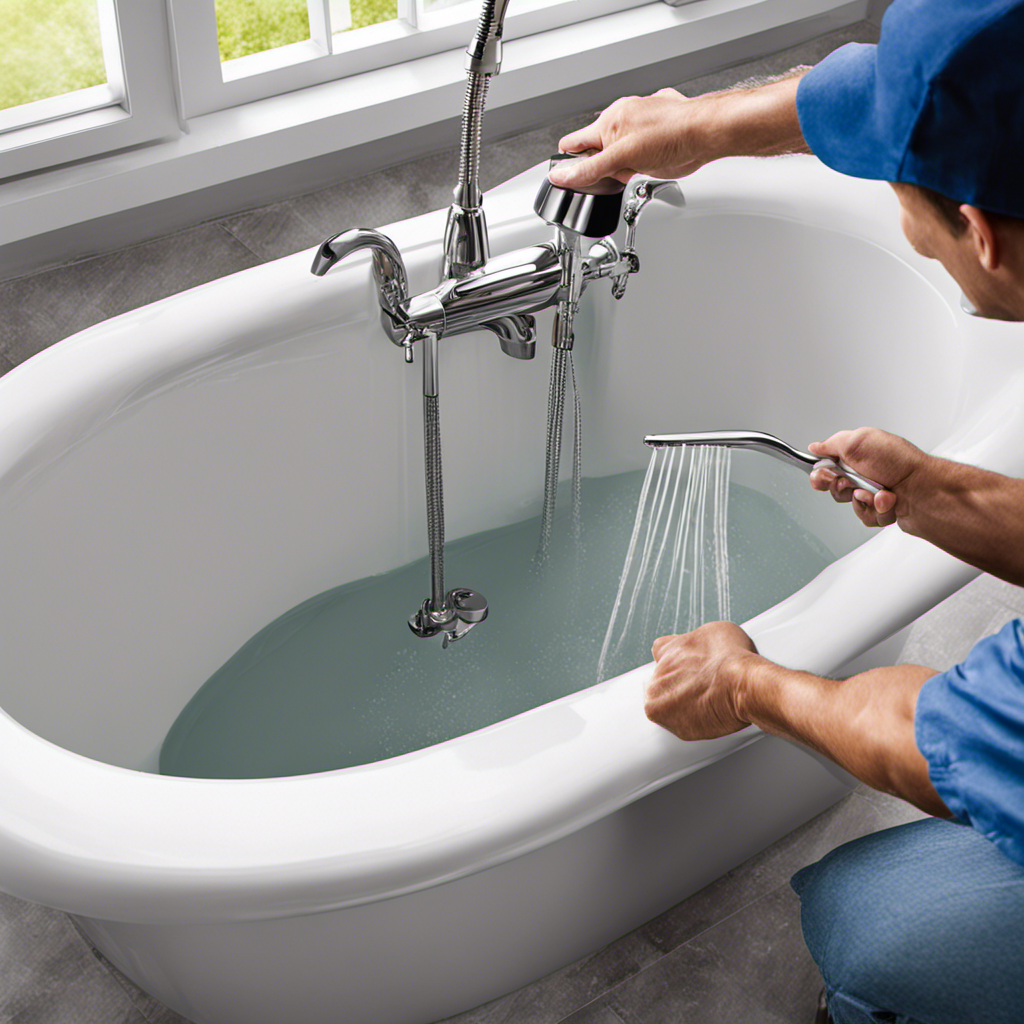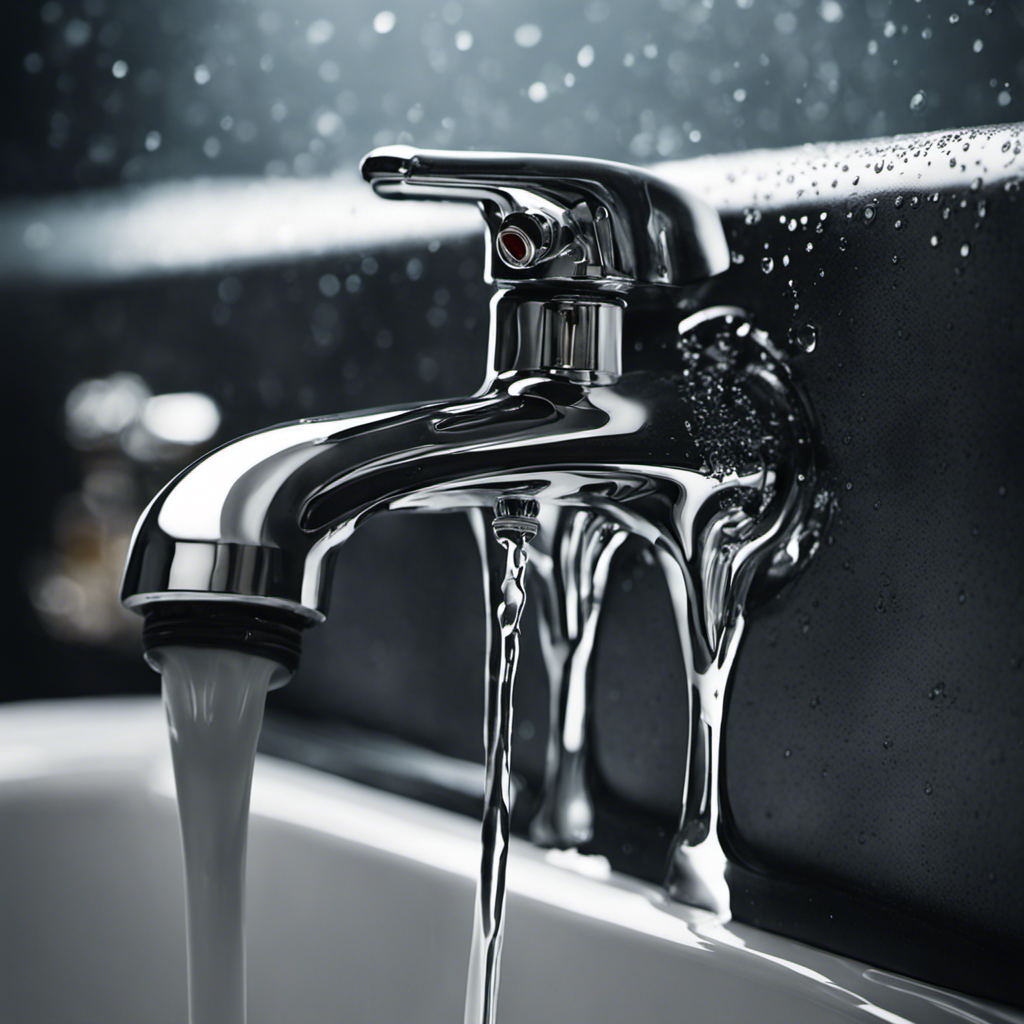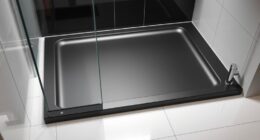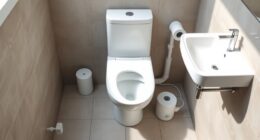I’ve been there – standing ankle-deep in water, waiting for my bathtub to drain. It’s frustrating and time-consuming. But fear not, because I’m here to show you how to fix a slow draining bathtub.
In this step-by-step guide, we’ll identify the cause of the problem, remove hair and debris from the drain, unclog it with a plunger or drain snake, clean the overflow drain, make a homemade drain cleaner, and even adjust or install a new drain stopper.
Say goodbye to those stagnant baths and hello to smooth drainage!
Key Takeaways
- Hair and soap scum buildup are common causes of slow drains
- Use gloves and a wire hanger to pull out any blockages
- Consider installing a hair catcher or drain strainer to prevent future blockages
- Seek professional help for persistent drain issues and avoid using chemical cleaners
Identifying the Cause of the Slow Drain
To figure out why your bathtub is draining slowly, you should start by checking for any hair or debris clogging the drain. Preventing blockages is essential for maintaining proper drainage in your bathtub.
The most common causes of slow drains in bathtubs are hair and soap scum buildup. These substances can accumulate over time and restrict the flow of water through the drain.
To identify the cause, remove the drain stopper and visually inspect the drain for any blockages. If you see hair or debris, use a pair of gloves and a wire hanger to pull out the clog. Make sure to dispose of the waste properly to prevent further blockages.
Once the drain is clear, test the water flow to ensure the issue is resolved.
Removing Hair and Debris From the Drain
Start by clearing out any hair or debris that may be clogging the drain.
To effectively clear blockages and ensure proper drain maintenance, follow these step-by-step instructions.
First, locate the drain stopper and remove it. You may need to unscrew it or lift it out, depending on the type of stopper.
Next, use a pair of needle-nose pliers or tweezers to reach into the drain and pull out any visible hair or debris.
If the blockage is deeper, try using a drain snake or a wire coat hanger to reach further down. Gently push and twist the tool to break up the clog and pull it out.
Finally, run hot water down the drain to help flush out any remaining debris.
Regularly performing this simple maintenance task will keep your drain flowing smoothly and prevent future clogs.
Unclogging the Drain With a Plunger
Use a plunger to clear the clog in your drain by creating suction and dislodging any blockage. Here’s a step-by-step guide on how to effectively use a plunger to unclog your bathtub drain:
-
Start by filling the tub with enough water to cover the plunger’s rubber cup.
-
Place the plunger over the drain, ensuring a tight seal.
-
Push down firmly on the plunger and then quickly pull up, creating suction.
-
Repeat this plunging motion several times, increasing the intensity each time.
-
After a few attempts, check if the water starts to drain more efficiently.
-
If the clog persists, try using plunger alternatives like a drain snake or a baking soda and vinegar mixture.
-
Avoid these common plunger mistakes: using too much force, not creating a proper seal, or plunging too quickly.
-
Remember to clean the plunger thoroughly after use to prevent the spread of bacteria.
Using a Drain Snake to Clear Blockages
When it comes to tackling stubborn blockages in our drains, sometimes a plunger just isn’t enough. That’s when it’s time to bring out the big guns – the drain snake.
In this discussion, I’ll be covering the techniques for effectively using a drain snake to clear blockages, as well as providing some helpful tips for preventing blockages in the first place.
Drain Snake Techniques
To unclog your bathtub drain, you’ll wanna grab the drain snake and insert it into the drain. This simple tool is highly effective in removing obstructions and restoring proper drainage. However, there are alternative methods to consider if you don’t have a drain snake on hand. Here are some techniques to help you maintain a clean drain:
-
Baking Soda and Vinegar:
-
Pour 1/2 cup of baking soda into the drain.
-
Follow with 1 cup of vinegar.
-
Let it sit for 30 minutes.
-
Flush with hot water.
-
Boiling Water:
-
Boil a pot of water.
-
Carefully pour it down the drain in stages.
-
Repeat this process until the drain clears.
-
Wire Hanger:
-
Unwind a wire hanger and straighten it.
-
Create a small hook at the end.
-
Insert the hook into the drain and remove any debris.
Blockage Prevention Tips
If you want to prevent blockages in your bathroom drains, make sure to regularly remove hair and debris from the drain cover. This is one of the most effective blockage prevention techniques you can use.
Hair and debris tend to accumulate over time and can easily clog your drain, causing water to drain slowly or not at all. By removing these obstructions regularly, you can maintain a clear and smooth-flowing drain.
In addition to regular cleaning, it is also important to be mindful of what goes down your drain. Avoid pouring grease, oil, or large food particles down the drain as they can cause blockages.
Cleaning the Overflow Drain
To prevent future clogs in your bathtub drain, it’s important to take some preventive measures.
One key step is to install a drain cover or strainer to catch hair and debris before they can go down the drain.
Additionally, regularly removing hair and debris from the drain can help maintain proper drainage and prevent clogs from forming.
Preventing Future Clogs
You can avoid future clogs by regularly cleaning the bathtub drain. Here are some blockage prevention methods and common causes of drain clogs:
- Use a drain cover: A drain cover can catch hair and debris before it goes down the drain, preventing clogs.
- Flush with hot water: Once a week, pour a pot of boiling water down the drain to melt any built-up grease or soap residue.
- Use a drain snake: If you notice a slow draining bathtub, use a drain snake to remove any hair or other obstructions.
By following these preventive measures, you can keep your bathtub drain clear and prevent future clogs.
In the next section, we will discuss how to remove hair and debris from the drain to fix a slow draining bathtub.
Removing Hair and Debris
Once hair and debris accumulate in the drain, it’s important to remove them to prevent clogs. Here is a step-by-step guide on how to clear your clogged pipes and prevent future blockages.
-
Start by removing the drain cover using a screwdriver or your fingers.
-
Use a flashlight to locate the hair and debris inside the drain.
-
Use a pair of long-nose pliers or tweezers to gently pull out the hair and debris from the drain. Be careful not to push it further down.
-
Dispose of the hair and debris in a trash bag or bin.
-
To prevent future blockages, consider installing a hair catcher or drain strainer to catch any hair before it goes down the drain.
-
Regularly clean the drain by pouring boiling water down it to remove any residue that may cause clogs.
Checking and Cleaning the P-trap
First, make sure you have the necessary tools to remove and clean the P-trap in your bathtub. You will need the following cleaning tools:
- Plunger: This tool is essential for troubleshooting techniques. It can help dislodge any clogs or blockages in the drain.
- Wrench: Use a wrench to loosen the slip nuts that hold the P-trap in place.
- Bucket: Place a bucket underneath the P-trap to catch any water or debris that may spill out during the cleaning process.
To clean the P-trap, follow these steps:
- Place the bucket underneath the P-trap to catch any water.
- Use the wrench to loosen the slip nuts on both ends of the P-trap.
- Gently remove the P-trap from the drain pipe.
- Inspect the P-trap for any hair or debris and remove it.
- Clean the P-trap using warm, soapy water and a brush.
- Rinse the P-trap thoroughly and reattach it to the drain pipe, tightening the slip nuts securely.
- Run water down the drain to ensure it is flowing smoothly.
Using these cleaning tools and troubleshooting techniques, you can effectively check and clean the P-trap in your bathtub, helping to fix a slow draining issue.
Using Chemical Drain Cleaners
When it comes to unclogging drains, many people turn to chemical cleaners for their supposed effectiveness. However, it is important to consider the potential health hazards associated with these products.
In this discussion, I will explore the effectiveness of chemical cleaners and discuss the potential health hazards they pose. Additionally, I will provide alternatives to chemical cleaners that can be equally or even more effective.
Effectiveness of Chemical Cleaners
Chemical cleaners can be effective in unclogging a slow draining bathtub. Here are some key points to consider:
-
Effectiveness of natural cleaners:
-
Natural cleaners, such as vinegar and baking soda, can be effective in removing mild clogs.
-
They are environmentally friendly and pose no health risks.
-
However, they may not be as powerful as chemical cleaners for more stubborn clogs.
-
Pros of chemical cleaners:
-
Chemical cleaners are readily available and easy to use.
-
They are highly effective in breaking down tough clogs.
-
They work quickly, saving you time and effort.
-
Cons of chemical cleaners:
-
Chemical cleaners contain harsh ingredients that can be harmful to the environment and your health.
-
They may cause damage to pipes if used incorrectly or in excess.
-
Continuous use of chemical cleaners can lead to the buildup of resistant bacteria.
Remember to always follow the instructions on the product label and consider the pros and cons before using chemical cleaners.
Potential Health Hazards
To prevent potential health hazards, make sure to read and follow the instructions on the product label when using chemical cleaners.
When dealing with a slow draining bathtub, it is important to first identify the cause of the issue. Often, the culprit is a clog formed by hair, soap scum, or other debris.
To tackle this problem, start by removing the drain cover and using a flashlight to inspect the drain. If you can see any visible blockages, try using a plunger or a drain snake to remove them.
If the clog is deeper within the pipes, you may need to use a chemical cleaner. However, be cautious as these cleaners can contain harsh chemicals that can be harmful to your health. Always wear gloves, goggles, and ensure proper ventilation when using these products.
Alternatives to Chemical Cleaners
If you’re looking for a safer option, there are alternatives to chemical cleaners that can effectively remove clogs in your bathtub. Here are some homemade drain cleaner recipes and natural ways to unclog drains:
-
Baking Soda and Vinegar:
-
Pour half a cup of baking soda down the drain.
-
Follow it with half a cup of vinegar.
-
Let it fizz for a few minutes.
-
Rinse with hot water.
-
Salt and Hot Water:
-
Mix half a cup of salt with a few cups of hot water.
-
Stir until the salt dissolves.
-
Pour the mixture down the drain.
-
Let it sit for a few hours.
-
Flush with hot water.
-
Boiling Water and Dish Soap:
-
Bring a pot of water to a boil.
-
Add a few tablespoons of dish soap.
-
Carefully pour the mixture down the drain.
-
Let it sit for a while.
-
Rinse with hot water.
These natural alternatives are effective and safer for both you and the environment.
Making a Homemade Drain Cleaner
First, grab some baking soda and vinegar to make a homemade drain cleaner for your slow draining bathtub. Homemade drain cleaner alternatives are a great option if you prefer natural drain cleaning methods. This simple and effective solution can help unclog your bathtub without the need for harsh chemicals.
Here’s how to make it:
- Start by pouring half a cup of baking soda down the drain.
- Follow it up with a cup of vinegar.
- Let the mixture sit for about 30 minutes.
- Boil some water and pour it down the drain to flush away the residue.
The combination of baking soda and vinegar creates a chemical reaction that helps break down the buildup in your drain. This natural method is not only effective but also safer for the environment and your pipes.
Give it a try and say goodbye to your slow draining bathtub.
Adjusting the Bathtub’s Pop-Up Drain Stopper
The pop-up drain stopper in your bathtub can be easily adjusted by unscrewing the cap and moving the linkage rod up or down. Here’s how to do it:
-
Unscrew the cap: Locate the cap on top of the stopper and twist it counterclockwise to remove it.
-
Adjust the stopper height: Move the linkage rod up or down to adjust the height of the stopper. If the stopper is not sealing properly, try raising it slightly.
-
Test the adjustments: Run water and observe if the stopper effectively seals the drain. If it still doesn’t work properly, continue troubleshooting.
-
Check for debris: Remove the stopper and clean any hair or debris that may be blocking the drain.
-
Inspect the linkage rod: Ensure that the rod is not bent or damaged. If it is, consider replacing it.
-
Reassemble the stopper: Screw the cap back on and test the stopper again.
By adjusting the drain stopper height and troubleshooting common issues, you can improve the performance of your bathtub’s drain.
Now, let’s move on to installing a new drain stopper.
Installing a New Drain Stopper
To install a new drain stopper, you’ll need to gather the necessary tools and follow these steps.
First, turn off the water supply to the bathtub to prevent any accidents.
Next, locate the drain cover and remove it by unscrewing or lifting it off.
Take note of the type of drain stopper you have, as this will determine the replacement you need.
Purchase a new drain stopper that matches the old one.
Once you have the new stopper, simply place it into the drain and secure it according to the manufacturer’s instructions.
Test the stopper by adjusting the water flow and ensuring it seals properly.
If you’re still experiencing drainage issues, it may be time to seek professional help for persistent drain issues.
Seeking Professional Help for Persistent Drain Issues
If you’re still having trouble with your drain, it might be a good idea to contact a professional for assistance. While there are many DIY drain cleaning methods available, sometimes the issue with your slow draining bathtub might be more complex than you can handle on your own.
Seeking professional advice can help you identify the root cause of the problem and ensure it is resolved effectively. Here are some reasons why contacting a professional for persistent drain issues is beneficial:
- Expertise: Professionals have the knowledge and experience to diagnose and fix complex drain problems.
- Specialized tools: They have access to specialized tools that can tackle stubborn clogs and ensure thorough cleaning.
- Preventing further damage: Professionals can identify any hidden issues that DIY methods might overlook, preventing further damage to your plumbing system.
Frequently Asked Questions
Can I Use Bleach to Clean the Drain?
Yes, you can use bleach to clean the drain, but I recommend using vinegar instead. Vinegar is a natural and effective solution for unclogging drains. There are also other natural drain cleaning methods available.
How Often Should I Clean the Overflow Drain?
I clean the overflow drain every month to prevent clogs. Bleach is an effective cleaner, but it’s important to dilute it before using. Regular maintenance helps keep the drain clear and prevents slow draining.
Can I Use a Wire Hanger Instead of a Drain Snake?
Yes, you can use a wire hanger as a temporary drain snake if you don’t have one. It’s one of the alternatives to drain snakes for unclogging bathtubs. Here’s how to do it step by step.
How Do I Adjust the Bathtub’s Pop-Up Drain Stopper?
To fix a slow draining bathtub, start by removing the bathtub drain stopper. Common reasons for slow draining include hair clogs and debris buildup. Follow these step-by-step instructions to ensure a smooth-flowing drain.
What Are Some Signs That I Need to Call a Professional Plumber for Drain Issues?
If you notice signs of severe drain blockage like slow draining or gurgling sounds, it’s time to hire a professional plumber. They have the expertise to diagnose and fix the problem efficiently.
Conclusion
So there you have it, folks! By following these step-by-step instructions, you can easily fix a slow draining bathtub.
I know it can be frustrating when you’re trying to take a relaxing bath and the water just won’t go down. But fear not, with a little bit of investigation and some simple tools like a plunger or a drain snake, you can tackle this problem on your own.
Remember, sometimes it might be necessary to call in the professionals if the issue persists. But for now, give these methods a try and enjoy a smooth, fast-draining bathtub once again!










